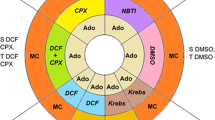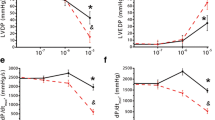Summary
In isolated perfused rat hearts with occlusion of the left coronary artery the release of adenosine and its degradation products inosine, hypoxanthine, xanthine and uric acid was investigated with and without exogenous addition of adenosine deaminase. In the control experiments large amounts of the adenine nucleotide catabolites appeared in the perfusate during coronary reperfusion. The greater part was represented by adenosine and inosine. During the coronary occlusion itself only a minor increase in the release of adenine nucleotide catabolites was observed, compared with the basal release before the coronary occlusion. Depending on the duration of the coronary occlusion more or less severe tachyarrhythmias occurred during the reperfusion of the previously ischaemic myocardium. Reperfusion-induced ventricular fibrillation was associated with a significant increase in the release of adenine nucleotide catabolites, compared with non-fibrillating hearts.
In the presence of exogenously-added adenosine deaminase the release of adenine nucleotide catabolites from reperfused hearts was further increased. Adenosine itself, however, almost completely disappeared from the perfusate. In adenosine-deaminase treated hearts the incidence of reperfusion-induced fibrillation increased, thereby contributing to the enhanced release of adenine nucleotide catabolites. However, the release was also increased by the enzyme when only the fibrillating hearts were considered, suggesting that rapid elimination of adenosine from the interestitial space also directly increases the release of adenine nucleotide catabolites from the heart.
Similar content being viewed by others
References
Achterberg PW Harmsen E, De Jong JW (1985) Adenosine deaminase inhibition and myocardial purine release during normoxia and ischaemia. Cardiovasc Res 19:593–598
Austin M, Wenger TL, Harrell FE, Luzzi FA, Strauss HC (1982) Effect of myocardium at risk on outcome after coronary artery occlusion and release. Am J Physiol 243:14340–14345
Balke CW, Kaplinsky E, Michelson EL, Naito M, Dreifuss L (1981) Reperfusion ventricular tachyarrhythmias: correlation with antecedent coronary artery occlusion tachyarrhythmias and duration of myocardial ischaemia. Am Heart J 101:449–456
Belardinelli L, Linden J, Berne RM (1989) The cardiac effects of adenosine. Progr Cardiovasc Dis 32:73–97
Bergey JL, Nocella K, McCallum JD (1982) Acute coronary artery occlusion-reperfusion-induced arrhythmias in rats, dogs and pigs: Antiarrhythmic evaluation of quinidine, procainamide and lidocaine. Eur J Pharmacol 81:205–216
Bernauer W (1982) Relation of enzyme release and ATP content in digoxin-intoxicated guinea-pig hearts. Basic Res Cardiol 77:449–459
Bernauer W (1991a) Post-ischaemic release of nucleosides and oxypurines in isolated rat hearts. Possible involvement of ventricular fibrillation. Basic Res Cardiol 86:1–10
Bernauer W (1991b) Increase in the post-ischaemic release of purine compounds in isolated rat hearts by the application of adenosine deaminase. Naunyn-Schmiedeberg's Arch Pharmacol 343 [Suppl]:R228
Bernauer W, Ernenputsch I (1988) Antagonistic effects of a-adrenoceptor blocking agents on arrhythmias, enzyme release, and myocardial necrosis in isolated rat hearts with coronary occlusion and reperfusion. Naunyn-Schmiedeberg's Arch Pharmacol 338:88–95
Berne RM (1980) The role of adenosine in the regulation of coronary blood flow. Circ Res 47:807–813
Collinson AR, Peuhkurinen KJ, Lowenstein JM (1987) Regulation and function of 5′-nucleotidases. In: Gerlach E, Becker BF (eds) Topics and perspectives in adenosine research. Springer, Berlin Heidelberg New York, pp 133–144
DeJong JW, Harmsen E, De Tombe PP, Keijzer E (1982) Nifedipine reduces adenine nucleotide breakdown in ischaemic rat hearts. Eur J Pharmacol 81:89–96
Dole WP, Yamada N, Bishop VS, Olsson RA (1985) Role of adenosine in coronary blood flow regulation after reductions in perfusion pressure. Circ Res 56:517–524
Fagbemi O, Parratt JR (1984) Antiarrhythmic actions of adenosine in the early stages of experimental myocardial ischaemia. Eur J Pharmacol 100:243–244
Gewirtz H, Brautigan DL, Olsson RA, Brown P, Most AS (1983) Role of adenosine in the maintenance of coronary vasodilation distal to a severe coronary artery stenosis. Circ Res 53:42–51
Hanley FL, Grattan MT, Stevens MB, Hoffman HE (1986) Role of adenosine in coronary autoregulation. Am J Physiol 25:H558-H566
Heinz F, Reckel S (1985) Adenosine. In: Bergmeyer HU (ed) Methods of enzymatic analysis, vol VII. VCH Verlagsgesellschaft, Weinheim, pp 110–117
Heller F, Olsson RA (1985) Inhibition of rat ventricular automaticity by adenosine. Am J Physiol 248:H907-H913
Heuer HJ, Bernauer W (1986) Myocardial damage by ventricular fibrillation in isolated perfused rat hearts, and its underlying mechanisms. Basic Res Cardiol 81:188–198
Johns TNP, Olson B (1954) Experimental myocardial infarction. I. A method of coronary occlusion in small animals. Ann Surg 140:675–682
Kane KA, Parratt JR, Williams FM (1984) An investigation into the caracteristics of reperfusion-induced arrhythmias in the anaesthetized rat and their susceptibility to antiarrhythmic agents. Br J Pharmacol 82:349–357
Knabb MT, Rubio R, Berne RM (1984) Calcium-dependent atrial slow action potentials generated with phosphatidic acid or phospholipase D. Pflügers Arch 401:435–437
Lubbe WF, Daries PS, Opie LH (1978) Ventricular arrhythmias associated with coronary artery occlusion and reperfusion in the isolated perfused rat heart: a model for assessment of antifibrillatory action of antiarrhythmic agents. Cardiovasc Res 12:212–220
Manning AS, Hearse DJ (1984) Reperfusion-induced arrhythmias: Mechanisms and prevention. J Mol Cell Cardiol 16:497–518
Meghji P, Holmquist CA, Newby AC (1985) Adenosine formation and release from neonatal-rat heart cells in culture. Biochem J 229:799–805
Newby AC, Worku Y, Meghji P (1987) Critical evaluation of the role of ecto- and cytosolic 5′-nucleotidase in adenosine formation. In: Gerlach E, Becker BF (eds) Topics and perspectives in adenosine research. Springer, Berlin Heidelberg New York, pp 155–168
Reimer KA, Jennings RB (1986) Myocardial ischaemia, hypoxia, and infarction. In: Fozzard HA, Haber E, Jennings RB, Katz AM, Morgan HE (eds) The heart and cardiovascular system. Raven Press, New York, pp 1133–1201
Rubio R, Knabb RM, Ely SW, Berne RM (1987) A critique on the use of adenosine deaminase to test the adenosine hypothesis: Disregarded implicit assumptions. In: Gerlach E, Becker BF (eds) Topics and perspectives in adenosine research. Springer, Berlin Heidelberg New York, pp 445–451
Saito D, Steinhart CR, Nixon DC, Olsson RA (1981) Intracoronary adenosine deaminase reduces canine myocardial reactive hyperemia. Circ Res 49:1262–1267
Schrader J, Rubio R, Berne RM (1975) Inhibition of slow action potentials of guinea-pig atrial muscle by adenosine: A possible effect on Ca+ influx. J Mol Cell Cardiol 7:427–433
Schrader J, Haddy FJ, Gerlach E (1977) Release of adenosine, inosine and hypoxanthine from the isolated guinea-pig heart during hypoxia, flow-autoregulation and reactive hyperemia. Pflügers Arch 369:1–6
Schrader J, Schtitz W, Bardenheuer H (1981) Role of S-adenosylhomo-cysteine hydrolase in adenosine metabolism in mammalian heart. Biochem J 196:65–70
Schütz W, Schrader J, uGerlach E (1981) Different sites of adenosine formation in the heart. Am J Physiol 240:H963-H970
Sparks HV, Bardenheuer H (1986) Regulation of adenosine formation by the heart. Circ Res 58:193–201
Szentmiklosi AJ, Nemeth M, Szegi J, Papp JG, Szekeres L (1980) Effect of adenosine on sinoatrial and ventricular automaticity of the guinea pig. Naunyn-Schmiedeberg's Arch Pharmacol 311:147–149
Wainwright ChL, Parratt JR (1988) An antiarrhythmic effect of adenosine during myocardial ischaemia and reperfusion. Eur J Pharmacol 145:183–194
Walker MJA, Curtis MJ, Hearse DJ, Campbell RWF, Janse MJ, Yellon DM, Cobbe SM, Coker SJ, Harness JB, Harron DWG, Higgins AJ, Julian DG, Lab MJ, Manning AS, Northover BJ, Parratt JR, Riemersma RA, Riva E, Russell DC, Sheridan DJ, Winslow E, Woodward B (1988) The Lambeth Conventions: guidelines for the study of arrhythmias in ischaemia, infarction, and reperfusion. Cardiovasc Res 22:447–455
Wallenstein S, Zucker ChL, Fleiss JL (1980) Some statistical methods useful in circulation research. Circ Res 47:1–9
Author information
Authors and Affiliations
Additional information
Send offprint requests to W. Bernauer at the above address
Rights and permissions
About this article
Cite this article
Bernauer, W. Effect of exogenous adenosine deaminase on arrhythmias and the release of adenine nucleotide catabolites in isolated rat hearts with coronary occlusion and reperfusion. Naunyn-Schmiedeberg's Arch Pharmacol 344, 544–550 (1991). https://doi.org/10.1007/BF00170650
Received:
Accepted:
Issue Date:
DOI: https://doi.org/10.1007/BF00170650




